Cookware for induction cookers: characteristics, types, brands and tips for choosing
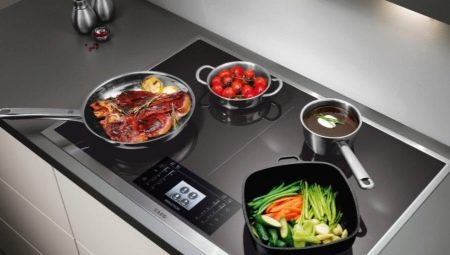
The emergence of fundamentally new types of technology not only expands the capabilities of people, but also forces them to figure out how to handle it. This also applies to induction cookers. It is important to know what kind of dishes can and should be placed on such hearths, what are the suitable materials.
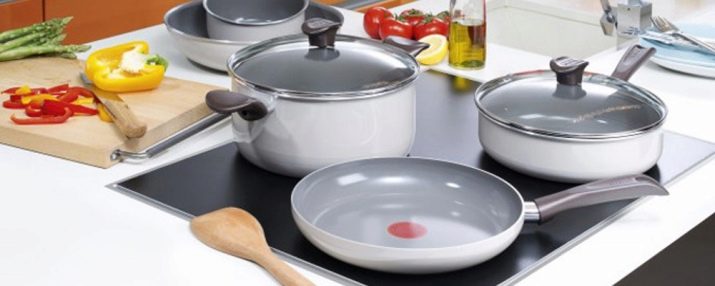
Features and requirements for dishes
Induction hobs are surrounded by a myriad of myths. You can often hear that they have such negative aspects:
- consume a huge amount of current;
- emit a strong hum and crackle;
- cooking food too slowly compared to traditional options.
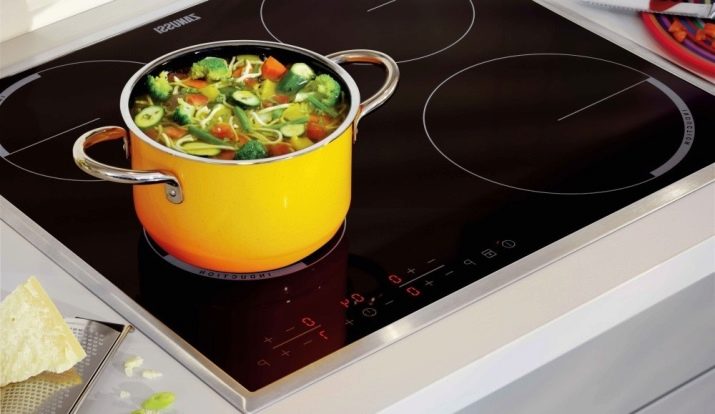
But in reality, all this is far from the case. Induction kitchen appliances have a number of important practical advantages, and most of the misunderstandings are associated with operating errors. One of them is the wrong selection of kitchen utensils. The principle of heating on this type of hearth involves the transfer of heat to the dishes using induced electric vortex impulses.

The oscillation frequency in this case is 20-100 kHz.
The difference between individual inductive cookers is due to the following factors:
- type of control board;
- features of the electric power unit;
- other design features;
- size;
- the format of embedding in furniture;
- a set of heating elements.
Engineers take great care to ensure that only the dishes that are suitable for them are placed on the stove. It is imperative that an automation is provided that recognizes suitable and unsuitable containers.As soon as the dishes are removed from the hob surface, the heating stops immediately. But the cookware for induction hobs itself differs from the usual one in that more stringent requirements are imposed on it.
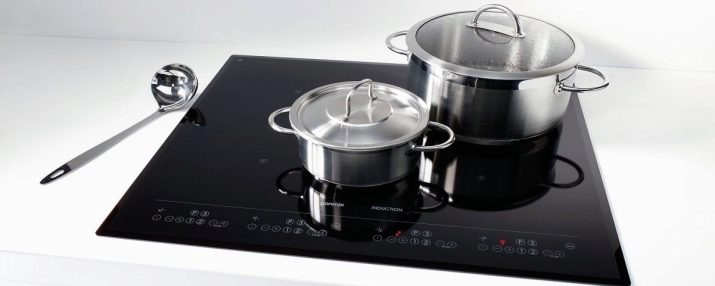
Only the containers corresponding to them allow you to realize all the advantages of the ultra-modern method of heating food.
In the technical descriptions, it is noted that products made from certain materials can be used for an inductive hearth:
- cast iron;
- made of stainless steel;
- made of black metal with an enamel layer and a flat bottom.

It is important to note that the magnetic field does not cause any damage to the enamelled coatings. But it should be borne in mind that special dishes are considered safer than the enameled variety. If the same pan moves in relation to the middle of the heating surface or is smaller in diameter than the burner, then the special cookware creates a dangerous electromagnetic field in a radius of 0.12 m, and the enamel one - in a radius of 0.2 m. It is noted that this induced field is potentially may harm the central nervous system.
As a result of long-term research, experts have found that modern induction cookers are safer than previously thought... Within dangerous radii, the radiation level (if high-quality devices are used) has become many times lower than the permissible limits according to medical standards. So you just need to avoid buying very old models of induction cookers - and then you can safely choose containers at your discretion.
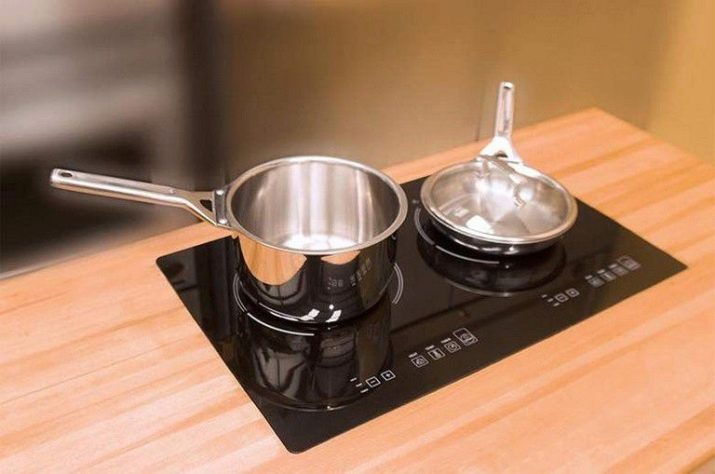
Most often they say that you need dishes that have an induction sign. It is executed in the form of a row of loops and is replaced (sometimes only duplicated) by verbal designations.
In addition, you need to pay attention to 3 important components when choosing kitchen utensils for an induction surface:
- lack of obvious deformations;
- completely flat base;
- exact covering of the active part of the burner (with placement in the middle of it).
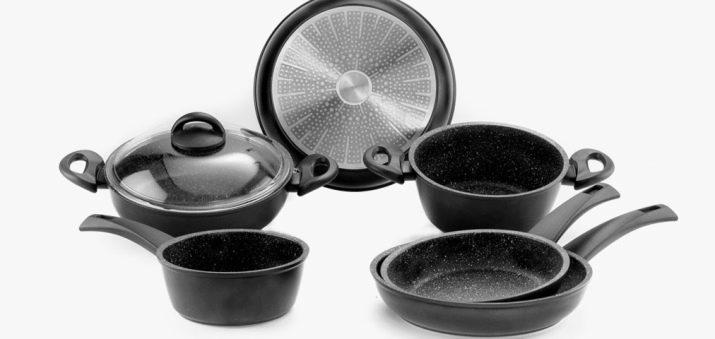
Induction must appear on the bottom of the cookware and on its documentation. But if there are no special designations, it is still sometimes possible to use containers. You need to check them with a magnet. Those products to which the magnet is attracted are precisely distinguished by their ferromagnetic characteristics. It will definitely not be possible to apply the following types:
- glass;
- ceramic;
- aluminum;
- made of brass;
- vessels made of copper.
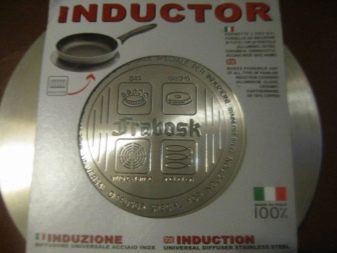
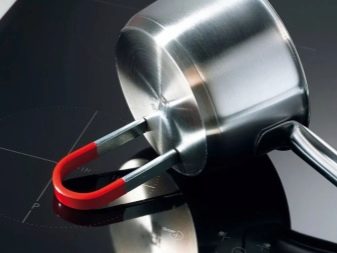
Varieties
Pans are often placed on induction hobs. They are distinguished from each other by the following parameters:
- applied material;
- total diameter;
- the depth of the bowl;
- geometry;
- handle designs;
- the presence or absence of a non-stick coating.
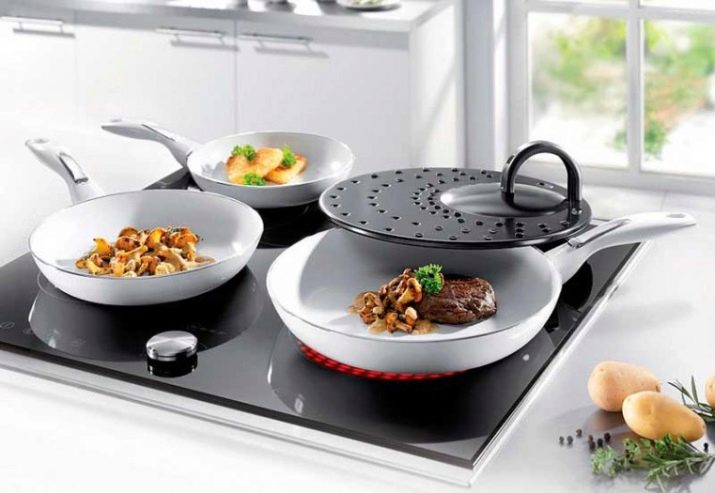
Most pans are round. The cover for them can be made of transparent or light-proof materials. The non-stick coating is predominantly made of polytetrafluoroethylene (more commonly known as Teflon). In addition to pans, pots are very often used.
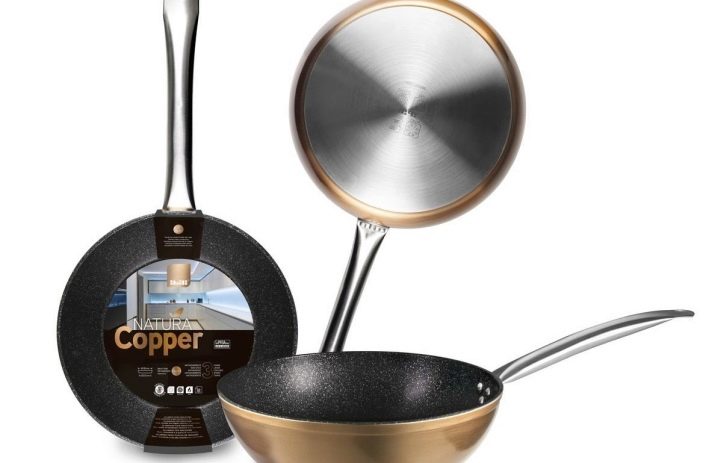
The width of the pot affects how convenient it is to mix its contents and how quickly the liquid will evaporate from the surface. Modest portions are prepared using pots with a capacity of 1-3 liters. Products with a volume of 3 to 5 liters are used to prepare soups and cereals, pasta and dumplings. The largest specimens (with a capacity of over 5 liters) help to boil compotes, pickle cucumbers or tomatoes, and make jam.
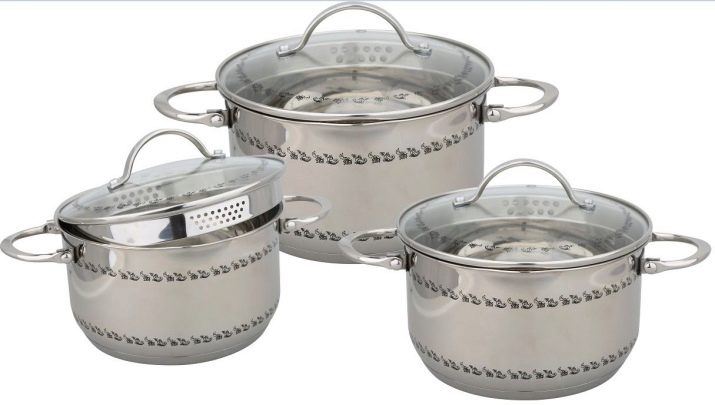
It is important to pay attention to the fact that this type of pots, like a cauldron, cannot be used on an induction hob - its bottom is not suitable for such an application.
In some cases, buckets and milk jugs are used. These vessels allow you to quickly heat or even boil small amounts of water, milk, and other liquids. Of course, one cannot fail to mention the kitchen kettles - they work quite well on an induction hob. A saucepan (a kind of hybrid of a pot and a high skillet) is used when you need to stew food.It is also convenient for making thickened soups.
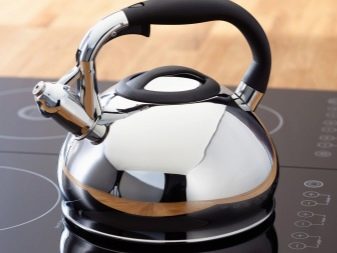
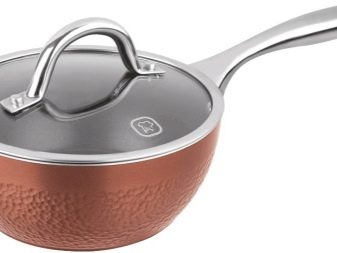
The double-bottomed saucepan is designed for cooking cereals. The gap separating the two bottoms from each other is filled with water. This solution eliminates the burning of food. As a result, the taste of food becomes delicate, pleasant, as if using a Russian oven. Steamers and steamers are also used quite often; they are divided into a lower container filled with water and into grates or baskets for food.
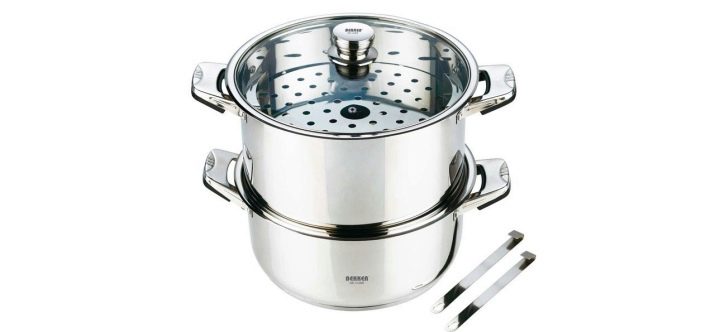
The difference between cookers and steamers lies in the arrangement of the tiers and in the different steam supply systems. Special pots for pasta are equipped with a special container with holes. Before starting cooking, the inner container is placed in the outer one, water is poured. As soon as it is ready, the inside is raised, pouring out the liquid.
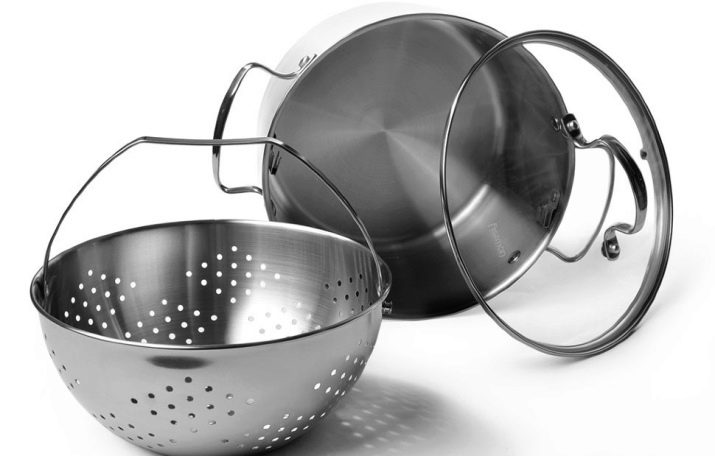
Shapes and sizes
As a general rule of thumb, you can use pans with a diameter smaller than the burner. But containers of a larger diameter cannot be used categorically. With the correct selection of dimensions, it is possible to provide additional savings of up to 10-20%. It should be borne in mind that the larger the volume of heated dishes, the lower the specific energy consumption will be. Therefore, it is necessary to carefully select the volume of dishes so as not to heat either too much or too little.
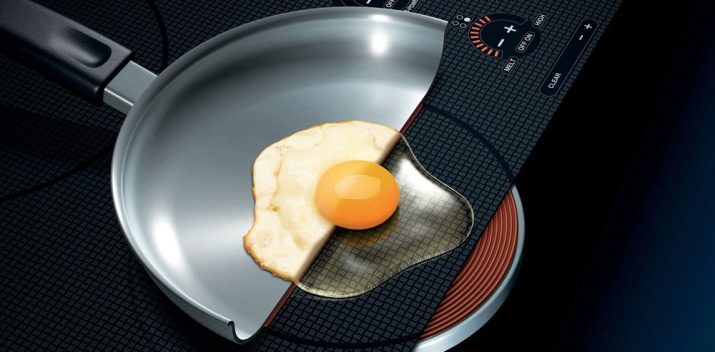
Heating 2 liters of water at the same time is more economical than heating 2 containers of 1 liter.
Connoisseurs therefore advise to choose not individual specimens, but whole sets. They allow you to confidently solve a variety of tasks. Selection should be based on family composition and food preferences.
Special attention should be paid to such a topic as the size of pans. Normally, they are measured not by the bottom, but by the upper edge. This information is always given in the description in stores. Therefore, when purchasing a frying pan with a diameter of 25 cm, you can be sure that the lid will have exactly the same dimensions. As for the bottom, its size is classified as follows:
- pans with a bottom with a diameter of 14.5 cm are considered small;
- the middle group includes products with a width of 18 cm;
- large cookware specimens with a width of 22.5 cm are recognized (these are the dimensions of the burners).
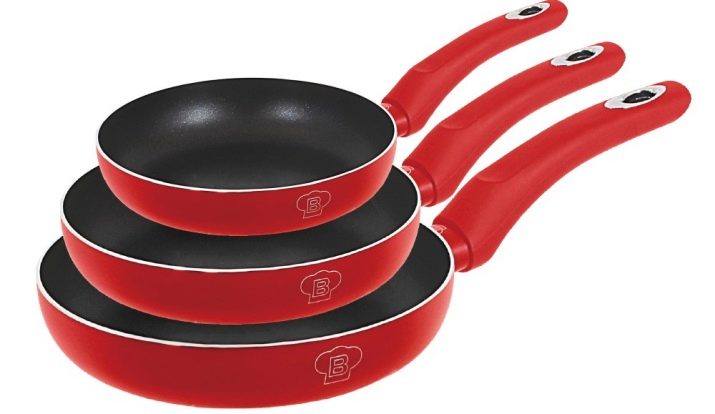
However, in real life, everything is somewhat more complicated. Modern hobs can have oval and rectangular burners. For them, you will have to select specific dishes. Spherical woks with a small flat bottom, due to the large size of the walls, will, as it were, displace other dishes and limit their use.
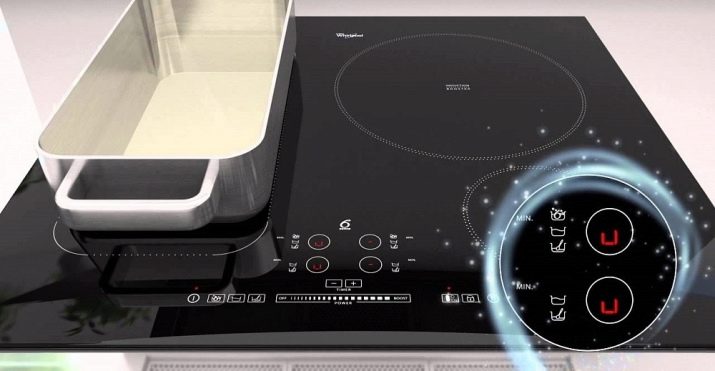
For the rest, the size of pans and pots must be selected taking into account your own needs and preferences.
Materials (edit)
As already mentioned, for cookware for an induction hob, the bottom must be strictly made of ferromagnetic materials. The most common options are:
- steel;
- cast iron;
- combination of steel and aluminum.
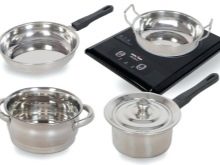
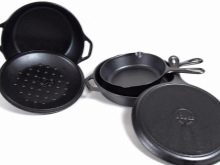
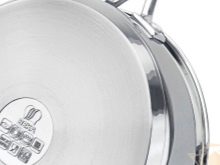
Copper pans are not suitable for induction cooking. Do not use clean aluminum cookware for induction cookers. But if the bottom is made of ferromagnetic material, and non-ferrous metal is used only for the walls and lid, then the situation changes. True, this somewhat slows down the heating of the vessel as a whole. The advantage of aluminum is that it is strong and lightweight. The oxide film formed upon contact with air excludes the penetration of toxic metal into the food being prepared.
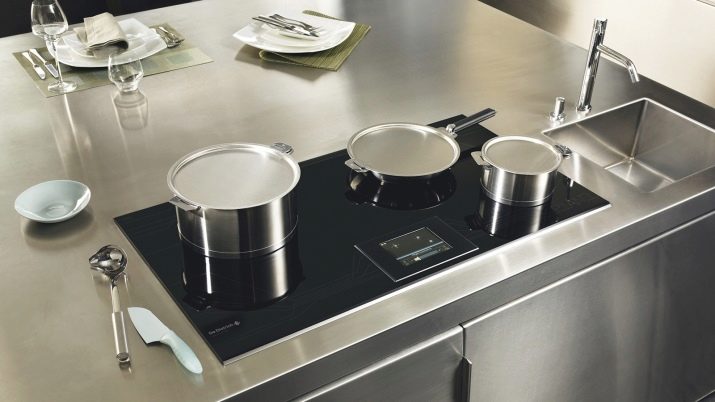
Aluminum structures are quite cheap and conduct heat well.
Even glassware can be used with a ferromagnetic bottom. It allows you to continuously monitor the cooking process. Chemical neutrality of glass eliminates harmful effects on products. Stylish teapots made of glass with a ferromagnetic base are quite widespread. Many firms make such products.
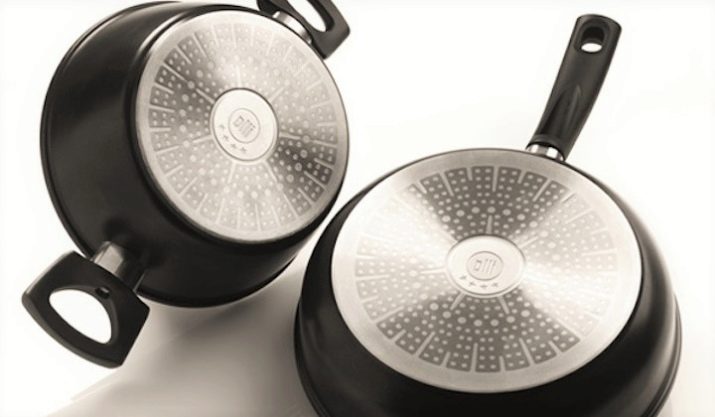
But cast-iron cookware is still a more familiar solution. The magnetic properties of cast iron are quite sufficient for solving basic culinary tasks.The main thing is that the bottom is completely flat and does not have the slightest mechanical defects. Without full-fledged docking of pans or pots with cooking structures, nothing can be achieved. Problems can only be caused by a serious mass of cast-iron containers, which can be difficult to keep.
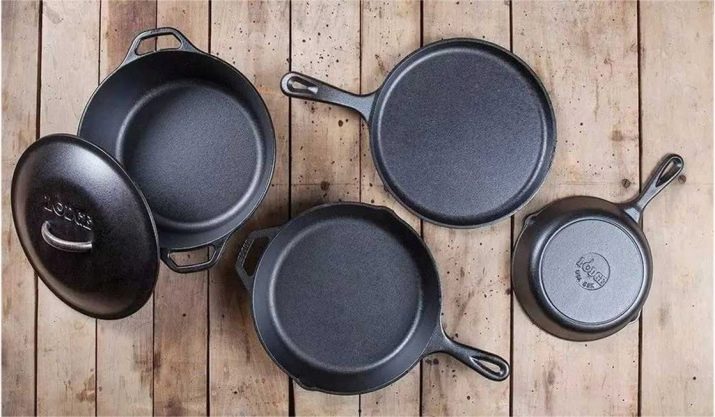
Enamel products are also widely used. But in order for them to work perfectly on an induction surface, you will have to choose the right metal layer on the walls and bottom. Exactly the same requirement is put forward in relation to stainless steel vessels. They differ in the following characteristics:
- they are well cleaned of the remaining food;
- pretty easy;
- are very expensive.
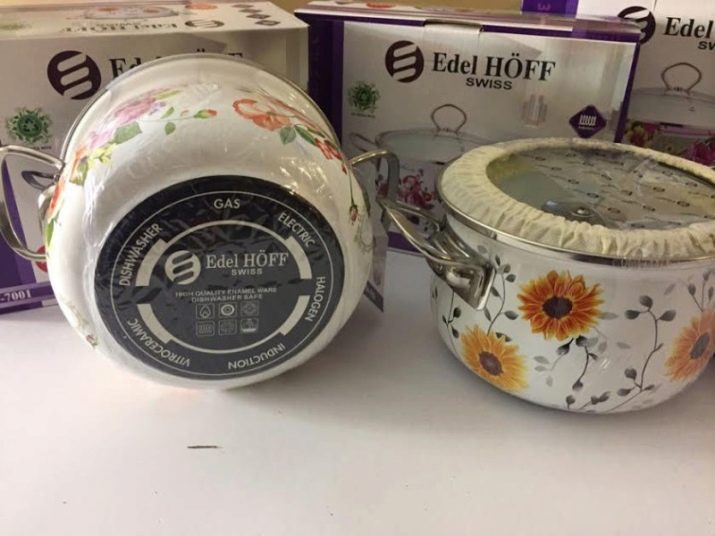
Manufacturers overview
Getting acquainted with cookware for induction cookers, one should pay attention not only to the best practical characteristics. The specific brand under which these products are made is of great importance. The ranking of the best samples includes products Rondell brand... This firm uses cast iron and stainless steel. Rondell cookware is characterized by ideal heating of food and is not subject to oxidation. Rondell offers a long-term warranty on its products.
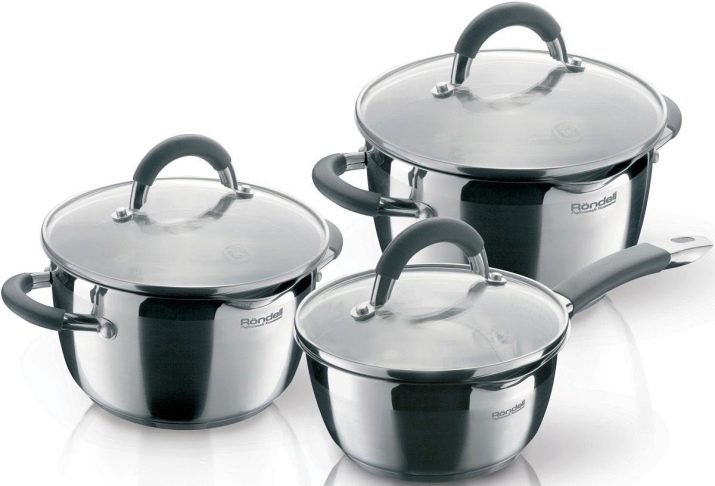
Stainless cookware has a 3-year warranty. Moreover, everything made of cast iron has a warranty period of 25 years.
Rondell's signature approach involves coating the cast iron inside and out with a special enamel. According to the developers, these products are suitable for any kind of stove. They were originally designed with a dishwasher in mind. The delivery set includes detailed instructions and a recipe book. There is only one drawback - a solid price.
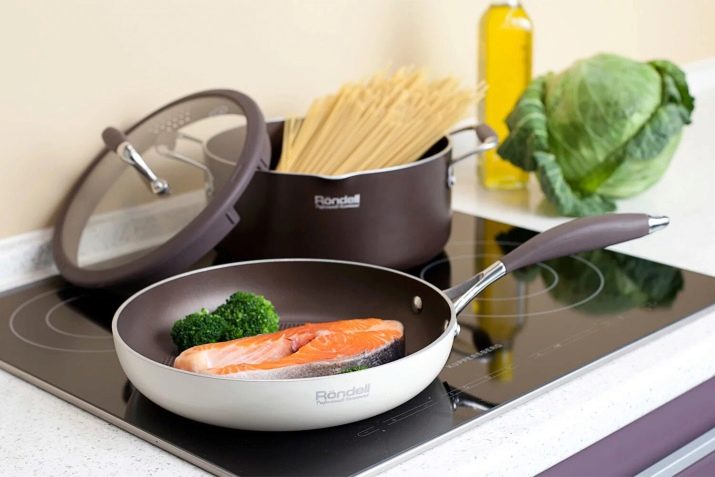
Among the popular dishes Tefal brands suitable for induction hobs Ingenio Expertise series... All kitchen utensils in this series are equipped with removable handles. The manufacturer claims that such products can be easily put in an oven, on a work table, in a refrigerator, in a kitchen cabinet.
Tefal Ingenio is positioned as an excellent option for improving your culinary skills. The interior is coated with the patented Titanium Excellence coating to prevent food sticking. The titanium layer helps to eliminate harmful effects when touched with a metal cutlery. It also reduces the risk of mechanical deformations of a different kind.
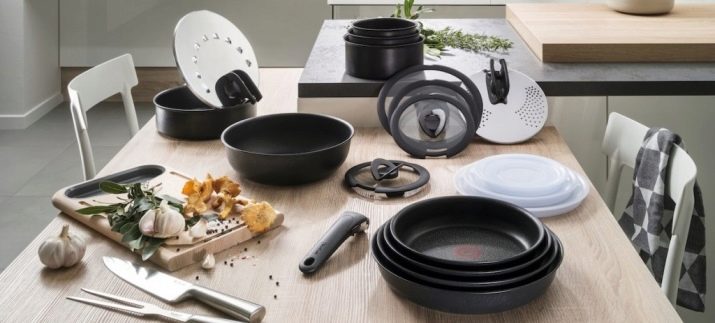
Compared to previous versions, the lifespan Tefal ingenio much more is declared - from 10 to 12 years. A special device provides an accurate temperature indication. The series includes three sets. They include in different configurations:
- pans with a diameter of 22 and 26 cm;
- stewpan 24 cm in section;
- bucket with a diameter of 16 cm;
- wok and ladle.
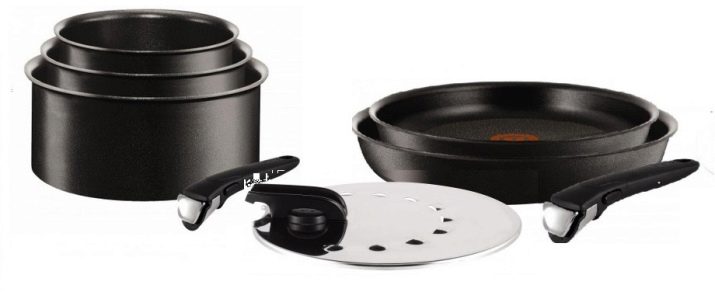
Good results, judging by the estimates of consumers, are also given by dishes. Kukmara brands... This company produces braziers and pans, saucepans and pans, ducklings and goose pans. The brand policy implies the use of granite coating, which provides excellent non-stick properties. The production of tableware is deployed at the Kukmor plant in Tatarstan, and the trade mark is named in honor of the enterprise.

Cast aluminum is used there for the manufacture of kitchen utensils. It is very thick - the walls can be up to 0.6 cm. This property allows you to achieve long-term use of kitchen utensils. The inside coating is supplied by a leading German manufacturer - by Weilburger Coatings GmbH... The composition is applied in 5 layers.
The marble components are complemented by mineral ceramic particles. The choice of spraying ensures the highest reliability and durability. The applied non-stick coating complies not only with the Russian quality standard, but also with the regulations adopted in the EU and the USA.
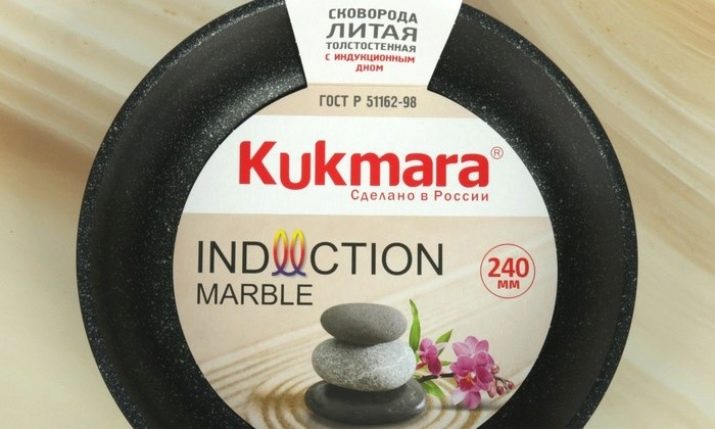
The manufacturer declares that the control of the characteristics of the finished cookware has also been brought in line with world regulations.
It is appropriate to continue the review of brands of utensils for inductive cookers using the example of products by Woll... According to the manufacturer himself, his products are optimal for both novice amateur chefs and reputable chefs. High-quality German products are created using the latest technologies. Manufacturing is 100% concentrated in one facility alone, where very strict quality control is carried out. However, the very technological process of manual production (without any automated stamping) inspires confidence. The Woll developers have proposed a unique aluminum alloy in composition, covered with a reliable non-stick coating.
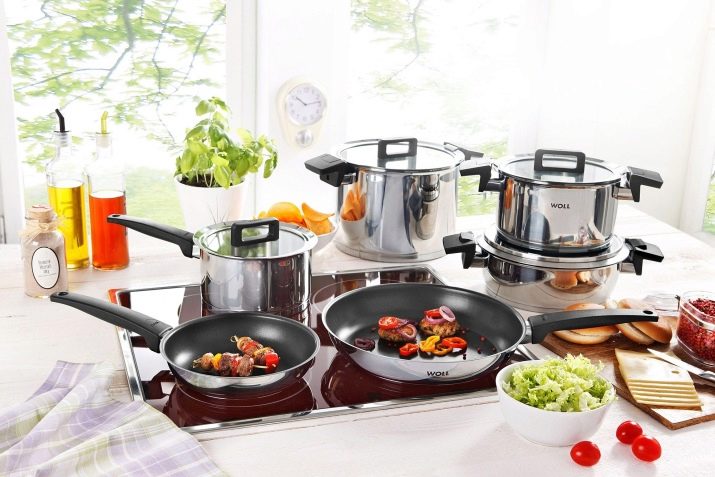
Thanks to this layer, you can cook absolutely any dish deliciously. At the same time, the consumption of fats and oils is reduced to the limit. Therefore, the food turns out to be much healthier than when using other structures. The Woll assortment includes:
- buckets;
- pots;
- saucepans and many other types of dishes.
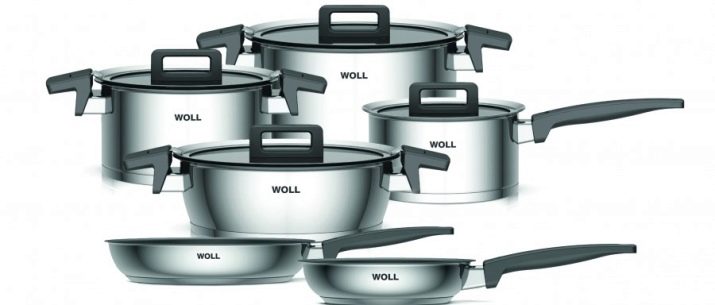
Attractive from Russian brands "Gourmet"on the market since 1991. This brand is the intellectual property of the enterprise. "VSMPO-Dishes"... The use of high-grade stainless steel made it possible to create dishes of no less quality than those promoted by the legendary "Zepter".
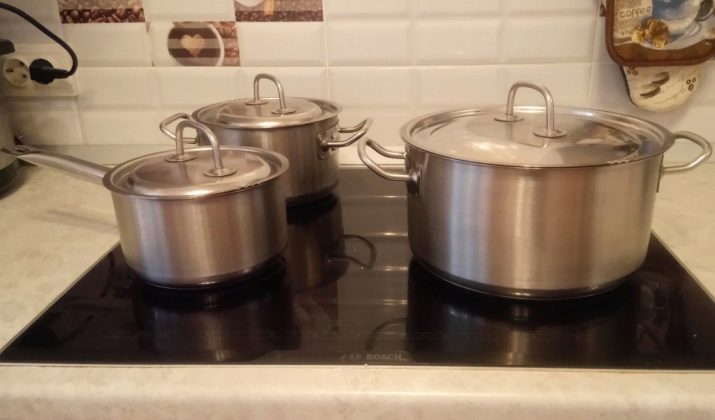
All surfaces of Gourmet products are completely smooth and even.
It is also worth paying attention to the following parameters:
- thick enough bottom;
- high quality build;
- the ability to cook food without adding water (if enough own juice is released);
- suitability of dishes for ovens (due to the absence of plastic);
- a wide selection (the assortment of the Russian enterprise includes pots up to 8 liters).
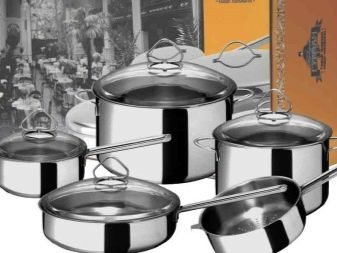
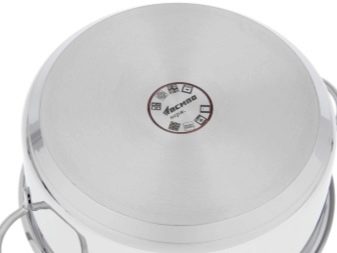
How to choose?
But no matter how famous the brand of the manufacturer of a set of dishes is, the choice of a set does not end there. Other considerations are also very important. The desire to test the ferromagnetic properties of the cookware is natural. In order to test fewer items with a magnet, or to look for special markings less often, you can first evaluate the appearance. A ferromagnetic pan, for example, looks more massive than a regular sample. You can also determine the truth for the price - high-quality utensils for induction cookers are not cheaply sold. Experts advise also to think about the size of kitchen utensils. They must match at least one of the cooking zones. But to find out the material used to create the walls is not too important. The presence of magnetic properties at the bottom is quite enough in practice.
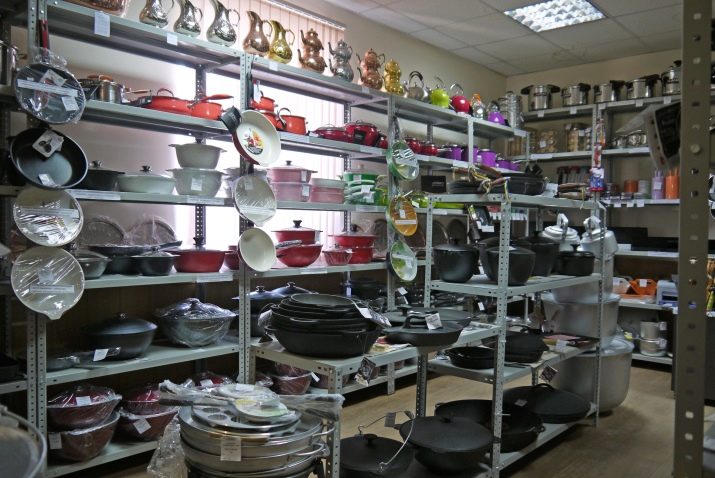
What is more important is the thickness of the bottom itself. It is best if it is 2-6 mm. Thinner layers of metal will bend and deform. Thicker ones do not warm up well and, in addition, are too heavy. If you need to cook food as quickly as possible (for example, going to work in the morning), the best option would be dishes that have a shorter height than width.
Terms of use
Induction hobs can even be used to prepare coffee in cezvas. However, in this case, you will have to use an adapter (sometimes it is called, depending on the source, an overlay or an adapter). Without special adapters, you can only use cookware with a bottom not narrower than 0.12 m. It is allowed to put even cookware with a width of 0.09 m or more on individual induction hobs.
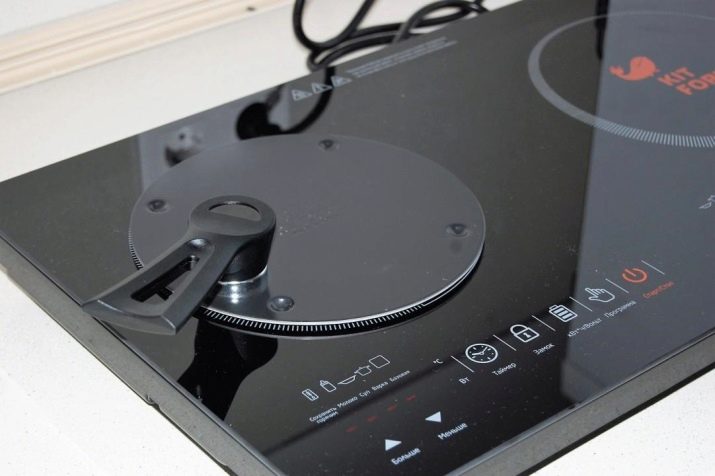
However, the final instructions on this score can be found only in the technical documentation. Unacceptable:
- use dishes with chipped edges and mechanical damage;
- place unnecessarily heavy containers on the induction cooker;
- allow inaccuracy in handling cast iron accessories.
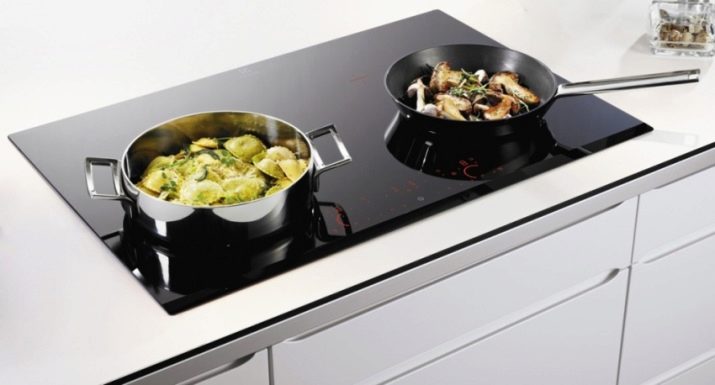
Care
The basic recommendations for the care of cookware for induction hearths are very simple. It is imperative to evaluate all funds for sanitary and environmental safety. It is best to wash the dishes by hand, and not trust this manipulation to the dishwasher. Powdered formulations should be used with caution.
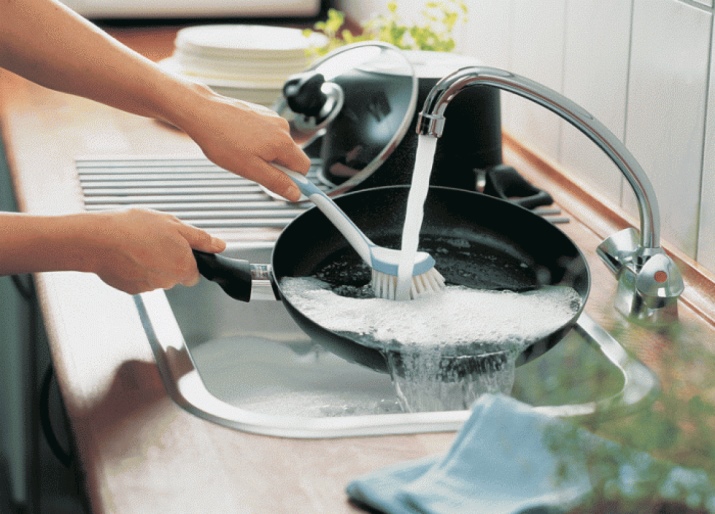
Abrasive particles sometimes severely damage the surface (especially bad if the dishes are made of aluminum or have a Teflon coating).
Experts advise:
- use only hot water for washing;
- pre-soak the dishes in water to soften the top layer of dirt;
- fight fat with vinegar;
- wash less dirty dishes first, and then more clogged ones;
- do not pour cold water into hot dishes (and vice versa);
- minimize the use of steel brushes or hard scourers and metal scrapers.
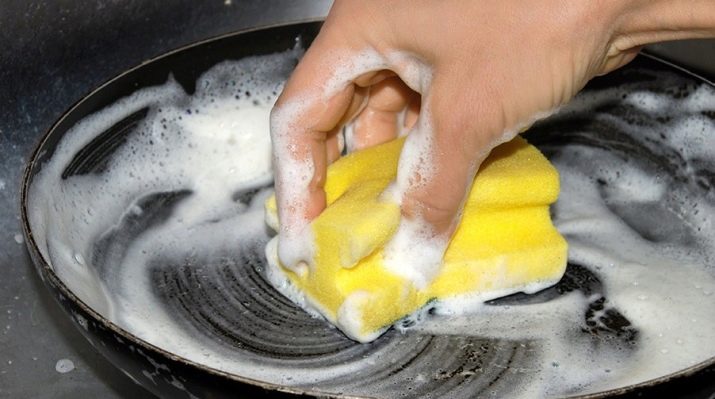
Alternatives with adapters
Thanks to the flat disc, which is installed between the stove and the cookware, it will be possible to use even the most ordinary cookware on the induction cooker. Including pots, coffee makers, pans. The inductance disk reaches 3-6 mm in thickness. It is always a multi-layer product. This accessory replaces the ferromagnetic bottom.
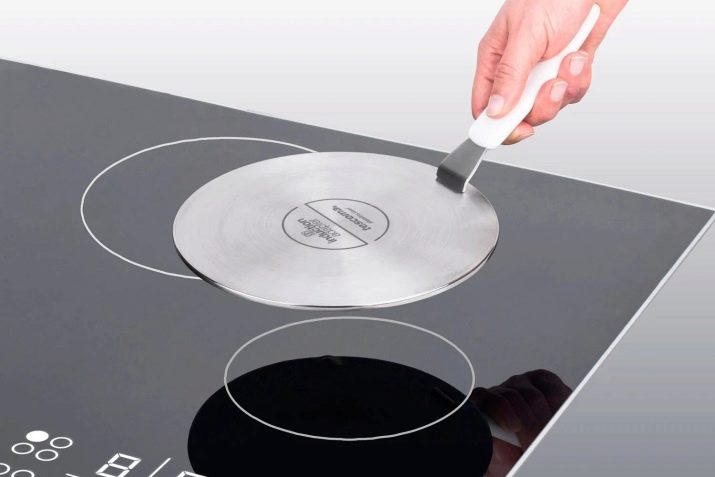
If it is used, containers made of ordinary and heat-resistant glass, ceramics of all grades, pouring clay, aluminum, copper can be used.
When choosing adapters, they think about the total thickness, the structure of the layers, the external color, the diameter (assuming that the bottom of the dishes captures 80% of the surface), the presence of a removable handle (provides additional convenience).
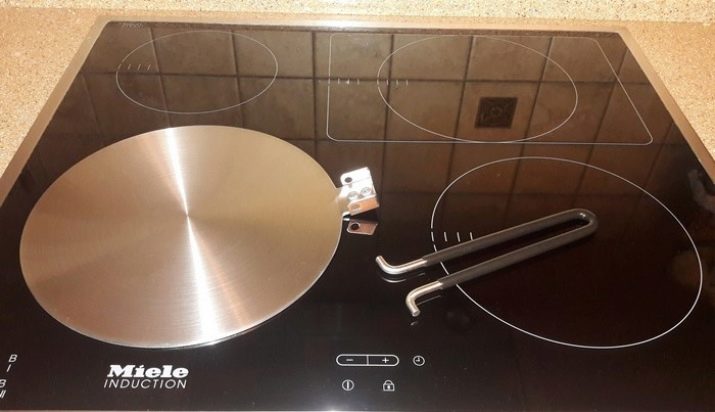
Review overview
Consumers give very good ratings to Rondell cookware. It works great with most induction hobs. Even the high price is fully justified. Good reviews are received for the products of the Thomas company. As an alternative, it is usually advised to consider Woll or the Czech brand Tescoma.
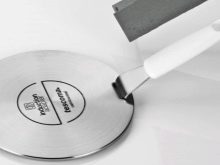
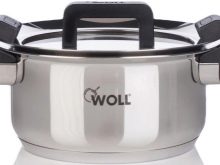
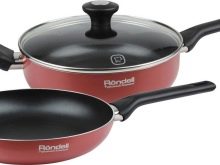
But Tefal products are rated somewhat less enthusiastically. Zepter products are of high quality, but sometimes unreasonably expensive. Also, the ratings of consumer demand invariably include such brands as BAF, Hackman, Lodge.
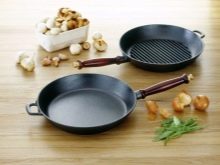
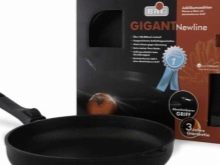
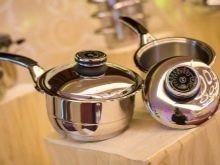
For information on how to choose the right cookware for induction hobs, see the video below.








